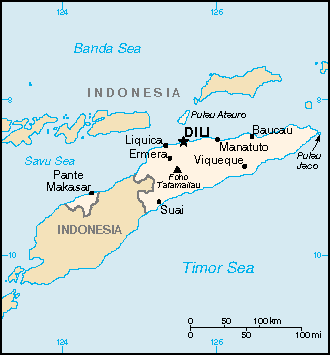|
East Timor
|

|
Capital: Dili
Population: 1,293,119
Brief History of East Timor:
East Timor is officially known as the Democratic Republic of Timor-Leste. The country occupies the eastern half of the island of Timor. The first Europeans to arrive in East Timor were Portuguese and Dutch traders around 1500. Over the years they began to build up outposts and local military strength. The Dutch and the Portuguese both struggled for influence over the land until they finally decided to divide up the land with the eastern half, which is today East Timor, going to Portugal in 1906.
During World War II, the country was occupied by Japan, but again became a Portuguese colony after the war. In 1974 Portugal decided to pull out of East Timor and the neighboring country of Indonesia soon invaded. The next several years were full of strive and unrest in the country as rebels tried to hold off the Indonesian invasion. Finally, in 1999, a peacekeeping force led by Australia entered the country ending the violence. East Timor, or Timor-Leste became an independent country in 2002.
The Geography of East Timor
Total Size: 15,007 square km
Size Comparison: slightly larger than Connecticut
Geographical Coordinates: 8 50 S, 125 55 E
World Region or Continent: Southeast Asia
General Terrain: mountainous
Geographical Low Point: Timor Sea, Savu Sea, and Banda Sea 0 m
Geographical High Point: Foho Tatamailau 2,963 m
Climate: tropical; hot, humid; distinct rainy and dry seasons
Major cities:
The People of East Timor
Type of Government: republic
Languages Spoken: Tetum (official), Portuguese (official), Indonesian, English
Independence: 28 November 1975 (date of proclamation of independence from Portugal); note - 20 May 2002 is the official date of international recognition of East Timor's independence from Indonesia
National Holiday: Independence Day, 28 November (1975)
Nationality: Timorese
Religions: Roman Catholic 90%, Muslim 4%, Protestant 3%, Hindu 0.5%, Buddhist, Animist (1992 est.)
National Symbol:
National Anthem or Song: Patria (Fatherland)
Economy of East Timor
Major Industries: printing, soap manufacturing, handicrafts, woven cloth
Agricultural Products: coffee, rice, corn, cassava, sweet potatoes, soybeans, cabbage, mangoes, bananas, vanilla
Natural Resources: gold, petroleum, natural gas, manganese, marble
Major Exports: coffee, sandalwood, marble; note - potential for oil and vanilla exports
Major Imports: food, gasoline, kerosene, machinery
Currency: US dollar (USD)
National GDP: $370,000,000
** Source for population (2012 est.) and GDP (2011 est.) is CIA World Factbook.
Back to Geography Home Page
